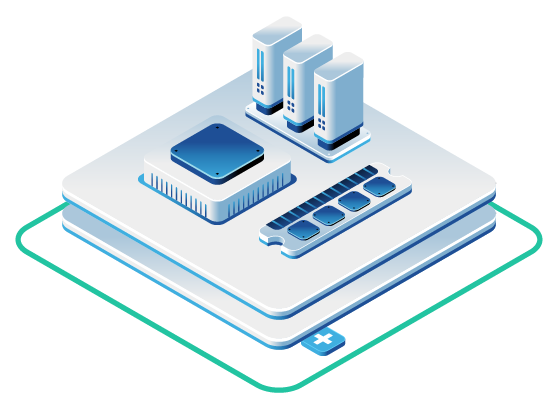In this article
- 1) Architecting a Resilient and Scalable Foundation
- 2) Implementing Seamless and Performant Networking
- 3) Ensuring Persistent, High-Performance Storage for Stateful Workloads
- 4) Building In Multi-Layered Security
- 5) Autoscaling for Performance and Efficiency
- Wrapping Up: Integrated Cloud Infrastructure with OpenStack and Kubernetes
- Interested in OpenMetal Cloud?
The ideal cloud scenario is to operate with the speed of the public cloud while retaining the control and cost-effectiveness of private infrastructure. This has led to the rise of two dominant open source projects: OpenStack for Infrastructure-as-a-Service (IaaS) and Kubernetes for container orchestration.
Viewing these platforms as competitors is a misconception. They’re powerful, complementary technologies. OpenStack manages the foundational infrastructure – compute, storage, and networking – while Kubernetes orchestrates the containerized applications running on top of that infrastructure. As Kendall Nelson from the OpenInfra Foundation shared in this talk, they are different yet complementary technologies that are being used more and more frequently together!
This symbiotic relationship is a globally adopted blueprint. According to Thierry Carrez, General Manager of the OpenInfra Foundation, “more than two-thirds of OpenStack deployments leverage the integration of OpenStack and Kubernetes, with tens of millions of cores globally implementing that open infrastructure blueprint”. This model delivers tangible benefits, including impressive cost savings and deployment flexibility.
To understand this integration, it’s helpful to map Kubernetes concepts to their OpenStack service equivalents.
Kubernetes to OpenStack Service Mapping
| Kubernetes Resource | OpenStack Equivalent | Description |
|---|---|---|
| Pod | Runs on a Nova VM (Worker Node) | The Kubernetes Pod executes on a virtual machine managed by OpenStack’s compute service, Nova. |
| Service (Type: LoadBalancer) | Octavia Load Balancer | A Kubernetes service requiring external exposure can trigger the creation of a load balancer via OpenStack’s Octavia service. |
| PersistentVolumeClaim (PVC) | Cinder Volume | A request for persistent storage is fulfilled by creating a block storage volume through OpenStack’s Cinder service. |
| Secret | Barbican Secret | Sensitive data can be securely stored by OpenStack’s key management service, Barbican, instead of using less secure default Kubernetes secrets. |
| NetworkPolicy | Neutron Security Group | Pod-level network rules are complemented by infrastructure-level firewalling from OpenStack’s networking service, Neutron. |
| Cluster Creation | Magnum Cluster Template | The entire lifecycle of a Kubernetes cluster can be managed as a resource using templates within OpenStack’s container orchestration engine, Magnum. |
This guide provides an analysis of five best practices for architecting, deploying, and managing Kubernetes on OpenStack.
1) Architecting a Resilient and Scalable Foundation
A successful integration begins with understanding the strengths and needs of your two pillars: OpenStack provides a stable, API-driven IaaS layer, while Kubernetes manages the application lifecycle on top. Infrastructure teams can focus on stability and efficiency, while developers can move with speed and agility.
Planning for Success: Hardware and Resource Considerations
A well-performing integration requires some initial hardware planning.
- Compute (Nova): Size physical servers with enough CPU and RAM to handle the OpenStack control plane, the Kubernetes control plane, and the containerized application pods.
- Storage (Ceph/Cinder): Prioritize NVMe-based SSDs for low latency and high throughput. For distributed and resilient storage, Ceph is the industry standard, providing a self-healing fabric ideal for persistent container volumes.
- Networking (Neutron): A baseline of 10Gbps networking is needed to handle the high volume of traffic between nodes, storage systems, and microservices.
Achieving High Availability with OpenStack
Application-level resilience in Kubernetes is insufficient if the underlying infrastructure is a single point of failure.
- Availability Zones (AZs): Distribute Kubernetes worker nodes across multiple Availability Zones (AZs) to ensure that a rack-level failure doesn’t cause a complete cluster outage.
- Self-Healing Storage with Ceph: Using Ceph as the backend for Cinder (block storage) is a cornerstone of a self-healing cloud. Ceph automatically distributes and replicates data, recovering from disk or node failures without manual intervention.
Streamlining Cluster Lifecycle with OpenStack Magnum
Manually managing Kubernetes clusters is complex and error-prone. OpenStack Magnum automates this entire lifecycle, making Kubernetes a first-class resource within OpenStack. Magnum uses other core services like Heat for orchestration, Keystone for security, Neutron for networking, and Cinder for storage to provision a fully configured Kubernetes cluster via the OpenStack API. This automation is very useful for achieving repeatable, scalable deployments.
2) Implementing Seamless and Performant Networking
Effective networking is a complex challenge, as OpenStack and Kubernetes approach it from different perspectives. OpenStack Neutron provides a centralized, infrastructure-focused model, while Kubernetes uses a distributed, application-focused model via the Container Network Interface (CNI). A naive integration can lead to inefficient “double-tunneling,” where a Kubernetes overlay network runs on top of an OpenStack overlay network.
OpenStack Kuryr: The Native Neutron Bridge for Kubernetes
To solve this, the community developed Kuryr, a CNI plugin for Kubernetes that acts as a bridge to the OpenStack networking layer. Kuryr makes Kubernetes pods first-class citizens on the OpenStack Neutron network. When a pod is scheduled, the Kuryr controller makes an API call to Neutron to create a network port, which is then plumbed directly into the pod’s network namespace. This eliminates double-tunneling, improves performance, and enables direct, routed communication between pods and VMs.
Advanced Neutron Services for Kubernetes
The Kuryr integration allows Kubernetes to consume advanced infrastructure services from Neutron:
- Load Balancing with Octavia: When a developer creates a Kubernetes
Serviceoftype: LoadBalancer, Kuryr translates this into an API call to OpenStack Octavia, which automatically provisions a robust, highly available load balancer. - Tenant Isolation and Security: Because each pod gets its own Neutron port, it can be placed in a tenant-specific network and associated with Neutron Security Groups. These act as stateful, distributed firewalls at the infrastructure level, providing a foundational layer of security that complements Kubernetes NetworkPolicies.
3) Ensuring Persistent, High-Performance Storage for Stateful Workloads
Managing persistent data for stateful applications was once a major challenge for Kubernetes. OpenStack’s block storage service, Cinder, provides the foundational solution. Cinder offers on-demand, self-service access to persistent block storage, abstracting the underlying hardware and presenting a simple API to request and manage volumes.
The Cinder CSI Plugin: Dynamically Connecting Kubernetes to OpenStack Storage
To bridge Kubernetes and Cinder, the community developed the Cinder Container Storage Interface (CSI) driver. This driver enables dynamic provisioning, a fully automated workflow. When a developer creates a PersistentVolumeClaim (PVC) in Kubernetes, the Cinder CSI driver detects it and orchestrates the API calls to Cinder and Nova to create a volume and attach it to the correct worker node, making it available to the application pod.
Advanced Cinder CSI Capabilities
The Cinder CSI driver exposes a rich set of enterprise-grade storage features to Kubernetes:
- Topology-Aware Provisioning: The driver understands the OpenStack Availability Zone topology and ensures that a pod’s storage is created in the same AZ, minimizing I/O latency.
- Volume Expansion: An operator can increase a volume’s size by simply editing the PVC manifest, often without application downtime.
- Volume Snapshots and Cloning: Users can create point-in-time snapshots of their volumes directly from Kubernetes, which are invaluable for backup, recovery, and creating dev/test environments.
- Raw Block Volumes: For high-performance applications like databases, the driver can present a Cinder volume as a raw block device instead of a mounted filesystem, giving the application direct, low-level control.
This integration brings storage management directly into the Kubernetes Infrastructure-as-Code (IaC) model, giving teams true self-service for the full application stack.
4) Building In Multi-Layered Security
Security cannot be an afterthought. The average cost of a data breach has reached over $4.9 million, with data compromises surging to a record high in 2023 with no signs of slowing down. A big portion of these breaches stem from preventable misconfigurations, making multi-layered security necessary.
Security Responsibility Matrix (OpenStack vs. Kubernetes)
Security Domain | Primary Responsibility | Key Contribution |
|---|---|---|
| Physical Security | Data Center/IaaS Provider | Secures the physical hardware and facilities. |
| Hypervisor & Host OS Security | OpenStack Administrator | Hardens the operating system and hypervisor. |
| Cloud-Level IAM & Tenancy | OpenStack Keystone | |
| Infrastructure Network Firewalling | OpenStack Neutron | |
| Secrets Management | OpenStack Barbican | Offers a hardened, centralized vault for cryptographic keys. |
| Container Image Scanning | CI/CD Pipeline | Scans images for known vulnerabilities before deployment. |
| Cluster-Level Authorization (RBAC) | Kubernetes API Server | Manages user and service account permissions within the cluster. |
| In-Cluster Network Firewalling | Kubernetes CNI (NetworkPolicies) | Provides fine-grained, pod-to-pod traffic control. |
| Runtime Security | Kubernetes Add-on (e.g., Falco) | Monitors container behavior for malicious activity. |
Key Security Controls
- Identity and Access with Keystone: OpenStack’s identity service, Keystone, provides centralized, multi-tenant authentication and Role-Based Access Control (RBAC). Enforcing the principle of least privilege here is critical.
- Secrets Management with Barbican: Default Kubernetes
Secretobjects are not encrypted at rest. The integration can work with OpenStack Barbican, a dedicated service for the secure storage and management of secrets and keys, often backed by a Hardware Security Module (HSM). - Layered Firewalling: Combine Neutron Security Groups for infrastructure-level perimeter defense with Kubernetes NetworkPolicies for granular, application-aware micro-segmentation inside the cluster.
- Supply Chain Security: Use a private registry (e.g., on OpenStack Swift) for trusted container images and integrate vulnerability scanning tools into the CI/CD pipeline to block vulnerable images from deployment.
5) Autoscaling for Performance and Efficiency
Autoscaling allows a platform to automatically adapt to changing demands, ensuring performance during peaks and minimizing costs during lulls. Kubernetes provides a sophisticated, multi-dimensional approach to this challenge.
The Three Dimensions of Kubernetes Autoscaling
- Horizontal Pod Autoscaler (HPA): Operates at the application level, adjusting the number of running pods (replicas) based on metrics like CPU or memory utilization.
- Vertical Pod Autoscaler (VPA): Also at the application level, this adjusts the CPU and memory resource requests and limits of individual pods to match their actual usage.
- Cluster Autoscaler (CA): Operates at the infrastructure level, adding or removing worker nodes (OpenStack VMs) to ensure there is enough capacity to run all required pods.
Kubernetes Autoscaler Comparison
| Autoscaler | What it Does | Scope | Trigger |
|---|---|---|---|
Horizontal Pod Autoscaler (HPA) | Application | CPU/memory utilization, custom metrics | |
| Vertical Pod Autoscaler (VPA) | Application | Historical resource usage | |
| Cluster Autoscaler (CA) | Infrastructure | Pending (unschedulable) pods |
The Autoscaling Chain Reaction
True cloud elasticity comes from the interaction of these three autoscalers.
- A traffic spike increases the CPU utilization of an application’s pods.
- The HPA detects this and scales up the application by creating new pods.
- If there isn’t enough capacity on the existing nodes, these new pods become
Pending. - The Cluster Autoscaler detects the
Pendingpods and provisions new worker nodes by making API calls to OpenStack Nova. - The new nodes join the cluster, and the scheduler places the
Pendingpods on them. - Later, as traffic subsides, the HPA scales down the pods, and the Cluster Autoscaler detects the now-underutilized nodes and terminates them to save costs.
Understanding this multi-layered, reactive chain is key to designing a fully automated, elastic cloud environment.
Wrapping Up: Integrated Cloud Infrastructure with OpenStack and Kubernetes
The integration of Kubernetes and OpenStack is a mature strategy for building powerful, flexible, and cost-effective private and hybrid clouds. Success depends on understanding their complementary roles and taking advantage of integration points to create a cohesive system.
For those looking to accelerate this journey, OpenMetal offers pre-integrated, production-ready OpenStack-powered environments designed to run demanding Kubernetes workloads, allowing teams to focus on application delivery rather than infrastructure complexity.
Schedule a Consultation
Get a deeper assessment and discuss your unique requirements.
Read More on the OpenMetal Blog


































